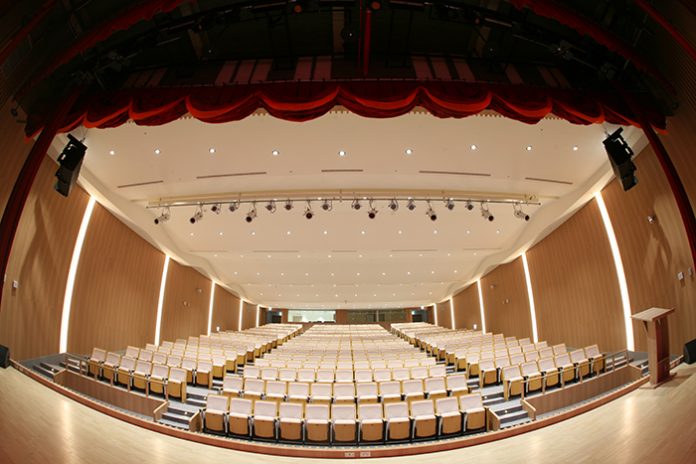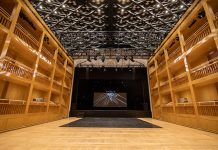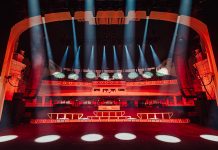Taipei Medical University, in the Xinyi district of Taiwan, has chosen a HOLOPLOT X1 Matrix Array as the audio solution for its Shuang Ho campus lecture theatre.
The medical lecture theatre is 25 meters long with highly reflective surfaces. It is used for a mixture of speeches, ceremonies, and seminars, both on-site and digitally delivered lectures for up to 430 students.
The requirement was for students and visitors to have the best possible intelligibility and an uncluttered aesthetic to guarantee a conducive learning environment for biomedical innovation.
The delivered solution is a compact left/right system with each hang consisting of four MD96 deployed in two 2 by 2, horizontal clusters.
“This allowed the screen on stage to remain unobstructed as the arrays are fixed closely underneath the ceiling, keeping the field of vision clear. A line array system would have required vertical hang length, causing an obstruction, which the project owners wanted to prevent,” states Sebastian Boeldt, Senior Applications Engineer at HOLOPLOT.
By creating a precise coverage zone for the seating area, HOLOPLOT X1 provides clear, even audio from the first to the last row of seats, without the need to raise the volume. The result is a comfortable, fatigue-free listening experience, allowing students to concentrate for longer and improving the overall learning experience.
“3D Audio-Beamforming technology allows X1 to ignore areas that could potentially cause reflections and focus sound just where it is needed. In this application, we excluded the stage area, improving gain before feedback, focusing the sound on the seating area,” Boeldt explains.
”Clear speech intelligibility was the key driver for this system design. We noticeably reduced the audio energy bouncing off the side walls, to get rid of unwanted reflections that would cause intelligibility issues.”
User-controlled software is pre-programmed to adapt to different configurations via presets, removing the need for re-rigging loudspeakers with configuration changes. Simple to operate, it can be used by any member of staff.
“We no longer need to apply large amounts of SPL to cover the entire space,” Terence Lee, EVP of integrator Dacoms reveals. “Higher volumes can cause echoes that lead to listening fatigue. The system is compact in size, yet powerful in its functionality. It immensely improves learning for the students and is incredibly flexible, allowing staff to work with presets to create the optimal learning environment.”





